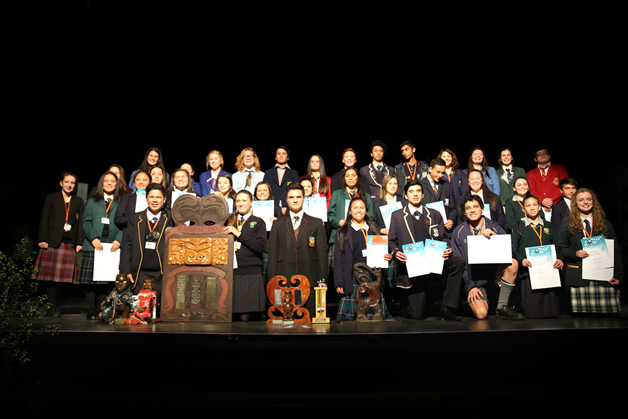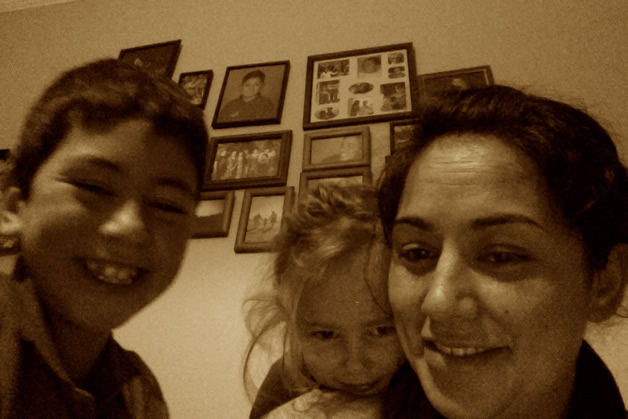Tātou ki te Whutupōro ki Ōtepoti – Te tauwhāika o te Toka
On Saturday 24 May, whānau from Ōtautahi, Ōtepoti and Waihola gathered in Dunedin to spend time together, to celebrate te reo and support their teams in the great southern rugby battle, Highlanders v Crusaders.
Whānau met at Moana Pool and the morning was spent swimming, hydro sliding and making friends. This event was for te reo enthusiasts of all levels and it was inspiring for whānau to meet other whānau, who shared this common passion. Those who converse in te reo daily were examples for those whānau who are still striving with and learning the language. People were thankful for the opportunity to practice our tikaka of whanaukataka, manaakitaka and kotahitaka.
After the pool we went to the Otago Museum. Tamariki enjoyed visiting the pūrerehua (butterflies) and exploring the many activities at Discovery World. The next stop was Te Tumu (University of Otago) for face painting and parehe (pizza). Even though Tawhirimātea spent a bit of time blowing up a storm the whānau were not fazed and proceeded to Forsyth Barr Stadium for the mighty match. Mei kore te taiwhanga me te tuanui.
Te mutuka kē mai o te pai. Eighty of us joined the thousands of spectators at the game. Looking the part with our team colours and face paint we were lucky enough to have Georgia Dawson (Nō Arowhenua) from our group selected to go on the field at half time to participate in the half time entertainment.
Although the score didn’t favour the Highlanders, everyone enjoyed the’ edge of your seat’ finish and talent displayed by both teams. Kei ruka noa atu kā kapa Crusaders me te kapa Highlanders hoki.
#ReoNominate
KMK will be celebrating, Te Wiki o te Reo and in preparation we are running a new competition in association with Tahu FM.
#ReoNominate is running from 15 June – 15 July.
Tukuna te reo kia rere. This competition is open to everyone and anyone, with some great prizes to be won.
Winners will be announced on Tahu FM during Te Wiki o Te Reo Māori. Keep an eye on our web-site and Facebook for more details. Karawhiua whānau.
Ngā Manu Kōrero ki Murihiku
The annual Otago-Southland Te Whakataetae o Ngā Manu Kōrero secondary school regional speech competition was hosted by Verdon College at the Civic Theatre, Invercargill on Friday 6 June. This year 42 speakers competed within the four sections. Pei Te Hurinui Jones – Senior Māori, Korimako – Senior English, Rāwhiti Ihaka – Junior Māori and Sir James Carroll – Junior English with impromptu speeches for the two senior sections.
Ka rere kā mihi ki kā manu tīoriori, kā korokoro tūī i tū kaha ki te atamira. Congratulations to all those students who rose to the challenge. It was an awesome occasion for rakatahi, kaiako and whānau alike. He mihi anō ki kā kaiako, kā tauira, kā kaimahi, ka kaiwhakawā, kā whānau me kā hoa i tautoko i te kaupapa nei. Also we acknowledge all those teachers, students, volunteers, judges, whānau and friends who supported and participated, and helped make this year’s contest such a success.
KMK were honoured to present taoka pounamu to the overall winners of the te reo Māori sections, both the Pei Te Hurinui Jones and Rāwhiti Ihaka section.
These recipients along with the other category winners will represent the region at this year’s national competition, being hosted in Hastings in September. Kia kaha rā koutou.
Pei Te Hurinui Jones – Senior Māori
Overall Winner: Thomas Aerepo-Morgan
2nd: Matariki Wehi
3rd equal: Isimeli Tuivaga and Lydia Anderson
Rāwhiti Ihaka Junior Māori
Overall Winner: Rianni Wainui-Dunn
2nd: Koreana Wesley-Evans
3rd: Te Anahera Parata
Korimako Senior English
Overall Winner: Jacobi Kohu-Morris
2nd: Kahurangi Flavell
3rd: Phaedra Ngahooro
Sir Turi Carroll Junior English
Winner: Dallas Bowler-Scott
2nd: Shakayla Andrews
3rd: Rangimarie Koroheke Edwards

Ngā Manu Kōrero participants at the Ōtākou-Murihiku regional competition.
KMK Whānau Reo Fund
Whānau Reo Fund recipients Ariana Stevens, Arirangi Stevens, 9 and Komai Rider-Stevens, 4. Nō Arahura.
What are your whānau goals in regards to te reo Māori?
Our whānau goal is to use te reo in our home and our community every day. We want to increase our confidence to use te reo all the time, and improve our level of understanding. For the children this means looking for a school that will support their journey with te reo, and also making sure the reo we use in our home is more than just instructions or growling. I would also like to support my extended whānau to learn and use te reo if and when they wish to.
What are the benefits of applying for Whānau Reo funding?
The financial support my whānau gets from Whānau Reo enables us to attend events and connect with the wider reo speaking community that I would otherwise be unable to attend. For my whānau this means we have been able to develop and strengthen relationships within the community, practice using te reo in many different settings, and have some fun along the way.
What are some of the KMK events that your whānau has attended through the Whānau Reo fund?
We have been on haerenga to Amuri (Hanmer Springs) and Takapō (Tekapo). These trips have been a great chance to get out and about and do different activities with other whānau speaking te reo.
We also attend Kura Reo Kāi Tahu each year. This is a great chance for me to extend my own reo, and also improve my knowledge of Ngāi Tahu histories, stories, and dialect.
What are some of the benefits for your children in being able to speak two languages?
Being able to speak te reo has acted as a doorway for my children to parts of te ao Māori that they may have otherwise been unable to access and/or understand. It also means we can have conversations in public which may otherwise be a little embarrassing. (Komai told me one day, quite loudly, that they old man sitting next to us looked like Santa. Luckily she said it in te reo so he had no idea).
Is there anything else you would like to add, as words of encouragement for those who have just started this journey or for whānau who are thinking about learning te reo Māori?
Learning te reo Māori is challenging. And it’s challenging for everyone in different ways. I used to think that it was just me who found it difficult, but it’s everyone. What’s the point in saying that? So when you start your journey, and it gets tricky, you know that it’s not just you.
Luckily, there is a wonderful community of people who can provide support, ideas, resources, a sympathetic ear, or a kick up the bum (depending on what you need). Despite the challenges I have faced, not only learning te reo, but using te reo in my home with my children each day, it has definitely been worth it for my whānau.
Te tamaiti ākoka i te kāika, tau ai i te marae.

The Stevens whānau.
Te Wiki o te Reo Māori 2014
Rāhina 21 – Rātapu 27 Toru/Hōngongoi
Māori Language Week 2014, 21-27 July
He kaupapa hou mō Te Wiki o te Reo Māori / New theme for Te Wiki o te Reo Māori
Ko ‘Te Kupu o te Wiki’/ “The Word of the Week.”
I raro i tēnei tāhuhu matua mō te wiki, ka whakanuia tētahi kupu Māori hou i ia wiki o te tau, mō ngā wiki rima tekau. E ākina ana ngā kura katoa, ngā hapori katoa, ngā whakahaere hoki kia whakamahi, kia kawe hoki rātou i taua kupu me ngā ākonga, ngā kaimahi anō hoki.
Under this theme, a new Māori word will be highlighted each week for fifty weeks. All schools, communities and organisations are encouraged to introduce and adopt that word with students, staff etc.
Ko tā ‘Te Kupu o te Wiki’ he āwhina i a Ngāti Niu Tīreni ki te whakapiki i ā rātou pātaka kupu Māori. Mā roto i tēnei kōkiri Te Kupu o te Wiki ka ako te hunga aroha ki te reo Māori i ētahi kupu Māori hei whakamahi mā rātou i ngā kōrerorero o ia rā.
‘Te Kupu o te Wiki’ will help New Zealanders to build their Māori vocabulary. Through Te Kupu o te Wiki, Māori language lovers can learn Māori words to use in everyday conversation.
Te Tūpuni a Wehi-nui-a-mamao
According to tradition, Wehi-nui-a-mamao wove together a cloak of stars and constellations. After his parents, Rakinui and Papatūānuku were separated, his brother Tāne asked for this cloak to be given to their father Rakinui. And so Rakinui is adorned with the many stars such as Puaka, Matariki, Takurua, Poutū, Meremere and Aotahi-mā-rēhua to name a few. The onset of winter is marked by the rising of the stars Puaka and Matariki, which at this time of year can be seen by the naked eye (weather permitting) in the early hours of the morning.
Reo o te wā – Language of the season
Marama: Maruaroa (June) Toru (July)
Kaupeka: Makariri/Takurua/Hōtoke – Winter
Whakatauki: Puaka kai rau – Puaka of a hundred foods
Ētahi o kā whetū
Puaka Rigel: the brightest star, a blue supergiant, in the constellation Orion.
Te Ika o te Raki: The Milky Way.
Tūmatauenga/Matawhero: Mars, the fourth planet from the sun and the second smallest in the solar system .
Rongo: Saturn, the sixth planet from the sun and the second largest in the solar system.
Autahi: Canopus, the second brightest star in the sky.
Rehua/Aotahi mā Rehua: Antares, the 16th brightest star, a red supergiant, in the Milky Way.
Tautoru: Orion, a constellation with many stars, including Rehua, Aotahi as well as the three stars in a row, often referred to as ‘the pot.’
Takurua: Sirius, the brightest star in the night sky.
Matariki: Pleiades, an open star cluster with seven prominent stars.
Poutū: Altair, the 12th brightest star in the night sky.
Meremere: Venus, as the evening star.
KMK events calendar
INITIATIVE: Te Wiki o te Reo
WHEN: 21 -27 Toru (July)
WHO / TE REO LEVEL: Tātou katoa
For all inquiries, registration forms or information on KMK initiatives please call the free phone 0800 KAI TAHU (0800 5248242) or check out our website:
www.kmk.maori.nz or Facebook https://www.facebook.com/kaitahureo